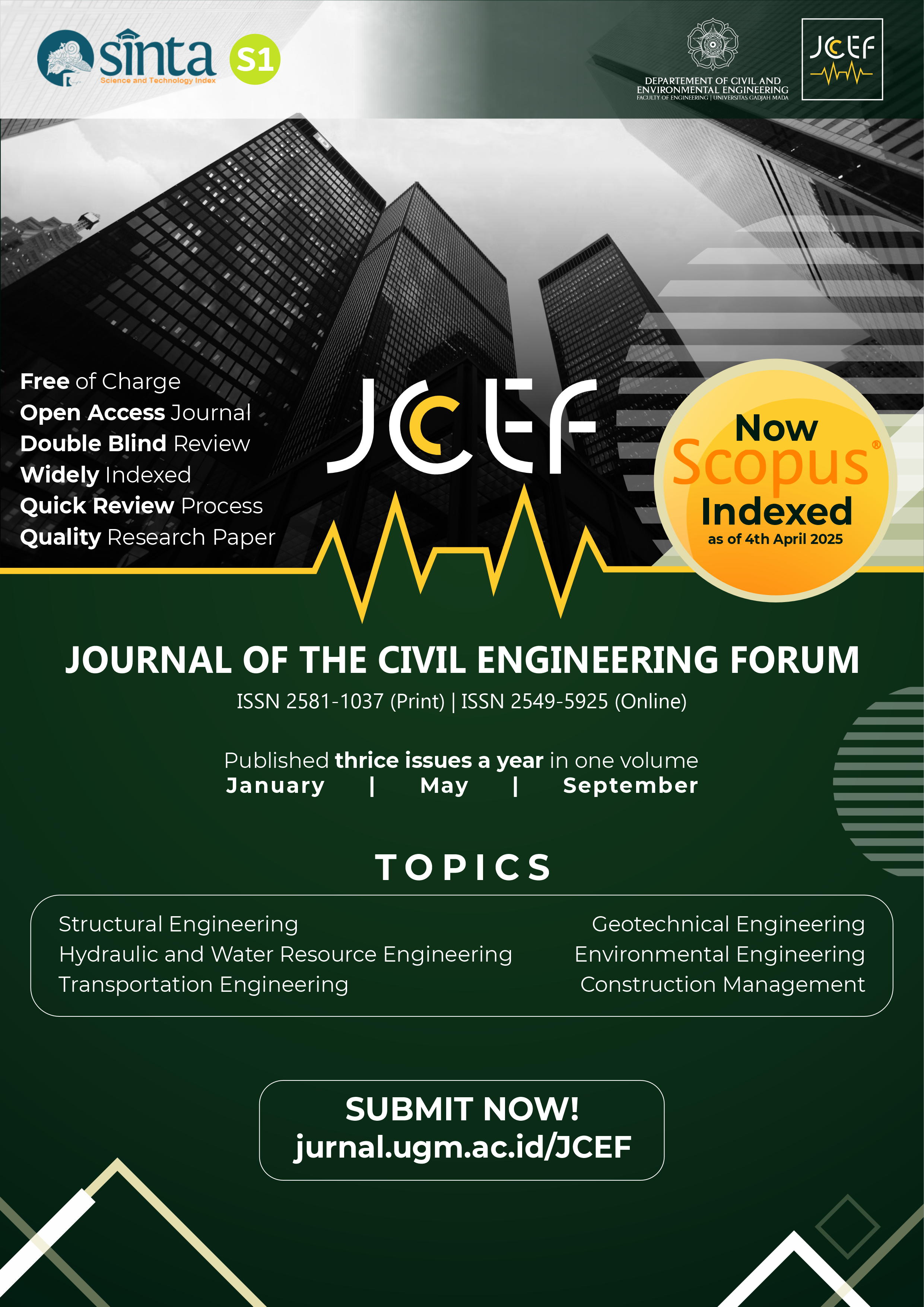Design of Stone Column to Mitigate Soil Liquefaction: Cases Study of Yogyakarta International Airport
Abstract
A low-to-medium cohesionless soil with low fines content was predominantly observed at the surfaces of Yogyakarta International Airport (YIA). The condition exposed subsoil of YIA to Liquefaction in addition to its location on a high seismic zone which has increased the likelihood of massive ground shaking. This means it is necessary to improve soil condition and vibro-replacement using stone column was selected as the appropriate method due to its recent popularity for the enhancement of sandy ground. Stone column has the ability to reduce the Cyclic Stress Ratio (CSR) of liquefiable soil and can be reliably evaluated. Therefore, this study was conducted to evaluate the risk of Liquefaction at YIA by adopting the SPT-based Liquefaction triggering procedure and presuming its manifestation using Liquefaction Severity Index (LSI). It is pertinent to state that the theoretical approach introduced by Priebe was used to design the geometry and center-to-center distance of stone column. The results were presented in the form of maps with a 50 m × 50 m grid size which include the cut and fill, LSI before and after improvement, stone column spacing, as well as stone column depth. It was discovered that the triangular spacing required for stone column ranged from 1.25 m to 2.5 m while the maximum depth was found to be 6 m. Moreover, stone column inclusion efficiently reduced the severity of Liquefaction from medium to very low for the areas studied. However, stone column has several limitations and this means a combination of soil improvement methods needs to be applied to areas with moderate LSI.
References
Badan Standardisasi Nasional, 2017. SNI 8460:2017 tentang persyaratan perancangan geoteknik.
Boulanger, R.W. and Idriss, I.M., 2014. Soil Liquefaction During Earthquakes. Department of Civil and Environmental Engineering, University of California, Davis, CA.
Bowles, J.E., 1996. Foundation analysis and design. 5th ed ed. New York: McGraw-Hill.
Castro, J., 2017. Modeling Stone Columns. Materials, 10(7), p.782. https://doi.org/10.3390/ma10070782.
Day, R.W., 2012. Geotechnical earthquake engineering handbook: with the 2012 International building code. Second edition ed. New York: McGraw-Hill.
Hartono, N., 2021. Pemetaan Potensi Likuefaksi dan Optimasi Perbaikan Tanah dengan Metode Stone Column di Kawasan Yogyakarta International Airport. Department of Civil and Environmental Engineering, Universitas Gadjah Mada.
Hartono, N. and Fathani, T.F., 2022. The Using of GIS to Delineate the Liquefaction Susceptibility Zones at Yogyakarta International Airport. Civil Engineering Dimension, 24(1), pp.62–70. https://doi.org/10.9744/ced.24.1.62-70.
Hutabarat, D. and Bray, J., 2019. Effective stress analysis of liquefiable site in Christchurch to discern the characteristics of sediment ejecta.
Idriss, I.M. and Boulanger, R.W., 2008. Soil liquefaction during earthquakes. Oakland, CA: Earthquake Engineering Research Institute (EERI).
Ishihara, K., 1985. Stability of natural deposits during earthquakes. In: 11th International Conference on Soil Mechanics and Foundation Engineering (San Francisco).
Iwasaki, T., Arakawa, T. and Tokida, K., 1982. Simplified procedures for assessing soil liquefaction during earthquakes. Proceedings of the Conference on Soil Dynamics and Earthquake Engineering, pp.925–939.
Priebe, H., 1995. The Design of Vibro Replacement.
PT. Nur Straits Engineering (NSE), 2017. Sub Surface Exploration Log ASTM D1586-11.
PT. Promisco Sinergi Indonesia, 2018. Laporan Faktual Penyelidikan Tanah Lokasi Air Side Proyek Pembangunan Bandara Internasional Yogyakarta.
Seed, H.B. and Idriss, I.M., 1971. A Simplified Procedure For Evaluating Soil Liquefaction Potential. J. Soil Mech. Found. Div., 97(9), pp.1249–1273.
Setiaji, R.R., Hakim, A.M., Adinda, F.H. and Abuhuroyroh, K.M., 2018. Dynamic Compaction at New Yogyakarta International Airport for Liquefaction Mitigation. In: 22nd Annual Indonesian National Conference on Geotechnical Engineering. Jakarta.
Skempton, A.W., 1986. Standard penetration test procedures and the effects in sands of overburden pressure, relative density, particle size, ageing and overconsolidation. Géotechnique, 36(3), pp.425–447. https://doi.org/10.1680/geot.1986.36.3.425.
Sonmez, H. and Gokceoglu, C., 2005. A liquefaction severity index suggested for engineering practice. Environmental Geology, 48(1), pp.81–91. https://doi.org/10.1007/s00254-005-1263-9.
Terzaghi, K., Peck, R.B. and Mesri, G., 1996. Soil mechanics in engineering practice. 3rd ed ed. New York: Wiley.
Tim Pusat Studi Gempa Nasional, 2017. Peta Sumber dan Bahaya Gempa Indonesia Tahun 2017.
Yogatama, B. and Adi Tirta, B., 2021. Python Application I Geotechnical Engineering Practices.
Copyright (c) 2023 The Author(s)

This work is licensed under a Creative Commons Attribution-ShareAlike 4.0 International License.
Copyright is granted to authors for the purpose of providing protection for articles written to describe experiments and their results. JCEF will protect and defend the work and reputation of the author and are also willing to address any allegations of violation, plagiarism, fraud, etc. against articles written and published by JCEF. JCEF is published under the terms of the Creative Commons Attribution-ShareAlike 4.0 International License (CC BY-SA 4.0). The author holds the copyright and assigns the journal rights to the first publication (online and print) of the work simultaneously.







